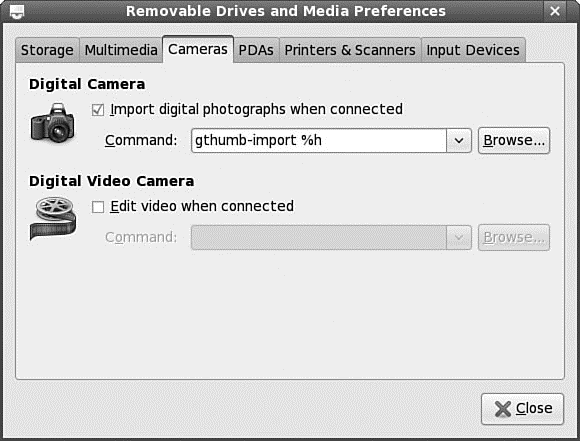Книга: Fedora™ Unleashed, 2008 edition
Handheld Digital Cameras
Handheld Digital Cameras
Digital cameras are one of the major success stories of the last few years. Now you can take pictures and see previews of your pictures immediately. The pictures themselves are stored on discs or memory cards that can be easily plugged into Fedora for further manipulation, using The GIMP or other software. Unfortunately, most of the supplied software that comes with the cameras tend to be for Windows users only, making you reliant on the packages supplied with Fedora.
The good news, though, is that because of the good development carried out in Fedora and GNOME, you are now able to plug pretty much any camera into your computer through a USB interface and Fedora automatically recognizes the camera as a USB mass storage device. You can even set Fedora to recognize when a camera is plugged in so that it automatically imports your photographs for you.
To do this, you need to set up your settings for removable drives and media. You can find this in the System, Preferences, Hardware menu. Click the Cameras tab and select the option to import digital photographs when connected (see Figure 7.6).

FIGURE 7.6 Use GNOME's intelligent handling of removable media by setting it to import your photographs automatically.
Now whenever you connect a digital camera to your computer GNOME automatically detects it (see Figure 7.7), and asks whether you want to import the photographs.

FIGURE 7.7 GNOME detects the presence of a digital camera and asks whether the photos should be imported.
By default GNOME uses the excellent gThumb package (see Figure 7.8), which, although basic-looking, offers an easy-to-use interface and powerful cataloging capabilities.

FIGURE 7.8 Make use of gThumb to manage your extensive photo collection.
- Using Digital Cameras with Fedora
- 1.3.8 Analog-to-Digital Converter
- 2.1.11 Analog-to-Digital Converter (A
- Digital UNIX
- Digital-грамотность в HR
- 9.3.3. MultiMediaCard и Sequre Digital
- Analog to digital conversion (A to D or ADC or A–D)
- Digital to analog conversion (DAC)
- The digital mirror
- Мини-кейс: Компания Digital Age Games




